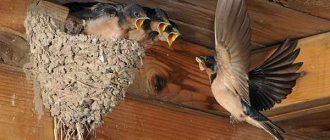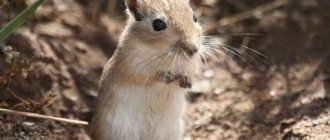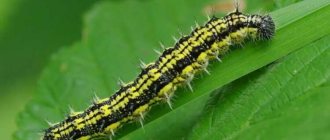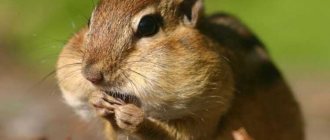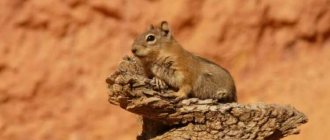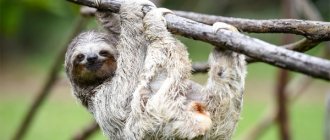Review author: “ZooVita”
Among the many different insects, the praying mantis stands out especially. This unusual predatory insect belongs to the order of praying mantises, which has about three thousand species. It got its name due to its special hunting position.
When the mantis prepares to attack its prey, it folds its forelimbs like a prayer gesture, which resembles a person praying.
Appearance of a praying mantis
The size of mantises varies from 1 to 11 cm. Depending on the species, these insects can differ significantly from each other in color and shape. But the structure of different individuals is mostly the same.
Praying mantises have a movable triangular head, a long elongated body, three pairs of limbs and two pairs of wings. The forelimbs are used for grasping prey, they are covered with spines and resemble a folding pocketknife. The four hind legs are thin and long, designed for locomotion.
Thanks to their green-yellow protective coloration, praying mantises are perfectly camouflaged among plants. Depending on the habitat, there are individuals of other colors: shades of gray and brown, as well as white, pink, orange and black.
What a praying mantis looks like depends largely on its environment. Thus, praying mantises that live and hunt in grass have a thin body, similar to a blade of grass or a stick.
Tropical mantises, on the other hand, have a wide, flat body that resembles a tree leaf.
Orchid mantises are skilled at hiding in flowers due to special lobes on their legs, indistinguishable in shape from orchid petals.
The art of camouflage
Praying mantises are known as unsurpassed masters of camouflage, skillfully using camouflage colors to blend harmoniously with the surrounding landscape. For example, some African species of mantises turn black in order to successfully hunt at fire sites.
Most predators are colored in a rich, grassy green color; there are beige and brownish specimens, and only 5 Asian species from the family Metallyticidae are distinguished by their blue-green color with a metallic tint.
Cunning insects can not only mimic the color of foliage, stones and trees, but also skillfully imitate leaves, shoots, grass stems and even fruit seeds with the position of their bodies.
Habitat of praying mantises
Praying mantises are widespread in areas with tropical and subtropical climates. They love warmth, so they thrive in humid forests and deserts. These insects can also be found in places with a temperate climate, mainly in steppes and meadows.
Most praying mantis species live in Central and Southern Asia, Australia, South America and Africa. In the European part they are also found, although much less frequently. They can be found in the countries of southern Europe, where it is dry and hot.
History of the name
People have known about praying mantises for a long time, but they were not studied in detail for a long time. Ignorance continued until the authoritative naturalist, member of the Academy of Sciences in Paris, Swede Carl Linnaeus, spoke about these amazing creatures more than 300 years ago.
In the written work “System of Nature”, the scientist gave insects their current names, the hero of the article was given the name from two words
-
God and prayer
. Why the author gave this name is now a mystery. But there is an opinion that this name was given because of the front legs, often folded as if the creature was praying. In 1758 the name "mantis" was given.
Zoologists were able to establish a habitat that includes most of the globe. They have a year-round cycle, do not hibernate and do not reduce their activity. Their lifespan is short, they live on average about a year
and during this time they grow up, hunt, lay offspring and die.
What do praying mantises eat?
Representatives of the order of praying mantises are considered especially dangerous predators, because mantises eat their arthropod counterparts: arachnids, insects and even other mantises. Moreover, cases of their attacks on vertebrates have been recorded. Large individuals ate snakes, frogs, small rodents, lizards and birds.
It is a known fact that female praying mantises eat males in almost half of the cases after mating. This cannibalism is explained by the fact that the female in this way compensates for the lack of proteins in the body that she needs to reproduce offspring.
In some cases, her own fragile cubs may become victims of her gluttony.
Cannibalism
Eating one's neighbor is not uncommon among praying mantises. This property is explained by concern for the younger generation. The eaten male becomes a source of food for the cubs. Females that kill mates lay more eggs.
Coitus does not always end with the destruction of the male. Only in 25-28% of cases does the female show aggression. During the mating period, the number of males eaten is 63%.
Reproduction of praying mantises
Praying mantises reproduce by laying eggs. The female, using a special solidifying liquid, creates an ootheca - a capsule in which she lays from 10 to 400 eggs. Ootheca is most often located on tree branches, in crevices of tree bark, and under stones. After 1-6 months, larvae emerge from the capsule, which become full-fledged adults after 5-10 molts.
In the tropics and subtropics, praying mantises can breed throughout the year. However, in the temperate zone, eggs are laid closer to autumn, and the maturation of the larvae lasts throughout the winter. Of the three stages of the life cycle, only in the egg stage are mantises able to overwinter.
Lifestyle of a praying mantis
The lifespan of praying mantises ranges from several months to a year. They are active mainly during daylight hours, when they hunt. Most photos show the praying mantis in its signature hunting pose, in which it remains for a significant part of the day. While waiting for prey, it remains motionless, which is why it merges with the nature around it and becomes invisible both to future prey and to other predators.
If there is enough food in the place where the mantis lives, it may not leave it throughout its life. This insect moves reluctantly, mainly at night. With the help of its wings, it is able to cover short distances, for example, fly to a neighboring tree or climb to a higher branch.
Diet
The common mantis is not a typical herbivorous insect, but is classified as a carnivore. It is capable of sitting in ambush for a long time, and then suddenly attacking its prey, which is larger than the insect itself in size.
The praying mantis diet contains:
- bees;
- butterflies;
- beetles.
Larger representatives attack frogs, small rodents, and small birds. Praying mantises can eat their relatives, this is especially true during the mating season and the drinking period.
Interesting!
Cases of attacks by praying mantises on hummingbirds, frogs and lizards, and mice have been recorded more than once.
For some animals, beetles themselves are food; they are hunted by birds, snakes, bats, as well as mantises themselves.
Who does the praying mantis fear?
The main enemies of praying mantises are birds, snakes, lizards, chameleons, some predatory insects and spiders. The praying mantis has several ways to protect itself from them.
First, swaying in an intimidating stance with the forelimbs raised up. With this pose, the praying mantis tries to appear larger in order to scare the offender.
Secondly, a special chirping sound, reminiscent of the hissing of snakes. It is created as a result of the friction of the wings on the abdomen.
Thirdly, there is a bright pattern on the wings, which the mantis spreads widely in case of danger. Some individuals have two dark spots on their wings, reminiscent of the eyes of a predator.
As a rule, the mantis will not be the first to attack a large animal or insect. However, when threatened, it will attempt to defend itself by biting or grabbing the enemy with its spiked front legs. If the attacker is significantly larger than the praying mantis, it is likely to fly away.
Precautionary measures
However, it should be remembered that an attack and bite from a praying mantis can pose a danger to children, especially young ones. Children, due to their curiosity and restlessness, can hunt these entertaining insects. An aggressive or frightened mantis may attack and harm the child:
- A child can be very frightened when attacked by a large insect with a rather frightening appearance.
- The mantis is more likely to injure thin children's skin than the skin of adults.
Therefore, while in nature, you should carefully look around so as not to accidentally disturb a praying mantis that is hunting or in the process of mating. It is necessary to explain to children that they should not grab insects and hunt them.
The benefits and harms of the praying mantis for humans
The praying mantis can benefit people, namely gardeners and gardeners. Living in the garden, it will eat aphids, beetles and other pests, thereby eliminating the need to spray plants with insect poison.
But there is a drawback to this: praying mantises consume both harmful and beneficial insects with the same appetite. Therefore, it is worth keeping in mind that as a result of his help, the number of bees and butterflies will most likely decrease.
As such, the praying mantis cannot cause harm to people. It is not poisonous, does not spoil the harvest, and does not spread infection. The only thing that the praying mantis is dangerous for humans is its teeth and spiny front legs.
Large individuals are capable of biting or piercing human skin, leaving painful wounds. But an attack by a praying mantis is only possible if it is disturbed.
Children should be especially careful with them. In defense, the praying mantis very quickly jumps on the offender, which can greatly frighten the child. But, as a rule, there are no serious consequences after its bite. Therefore, we can say that there is no great harm or particular benefit from mantises to humans.
Keeping at home
can live up to 1.5 years at home But they need appropriate conditions.
Terrarium
These insects require a small glass terrarium. Experts advise choosing it according to the size of your pet. It should be 3 times the length of the mantis in height. Inside the terrarium, twigs (artificial and live), moss, leaves, and coconut substrate are placed.
Conditions of detention
When choosing a terrarium, take into account the conditions of detention:
- Temperature. It should be between +25°C and +30°C. If necessary, additional heaters are used.
- Humidity. Praying mantises love high humidity, so the levels should be around 60%.
- too many praying mantises . One individual is enough in one terrarium, otherwise they will start eating each other.
Beginning praying mantis owners often have a question about how to determine the sex of a common mantis . As a rule, females are always significantly larger than males. In addition, it is possible to determine whether an insect belongs to one sex or another by the last segments.
Nutrition
Another problem is what to feed the praying mantis at home. This insect naturally hunts and immediately eats its prey. Therefore, it is recommended to feed the praying mantis in a terrarium with live food. Owners use aphids, locusts, grasshoppers, cockroaches, and various larvae. Some species happily feed on ants.
Nymphs are fed daily, adults are given food once every few days. The amount of food should correspond to the size of the insect. The praying mantis drinks water that is sprayed on the plants in the terrarium. It gets some of its moisture from food.
The mantis, the harm or benefit of this insect, has long been known.
As a predator, praying mantises support the natural abundance of insect pests in nature. But if there are too many praying mantises, they can destroy many beneficial insects (bees, etc.). Post Views: 576

